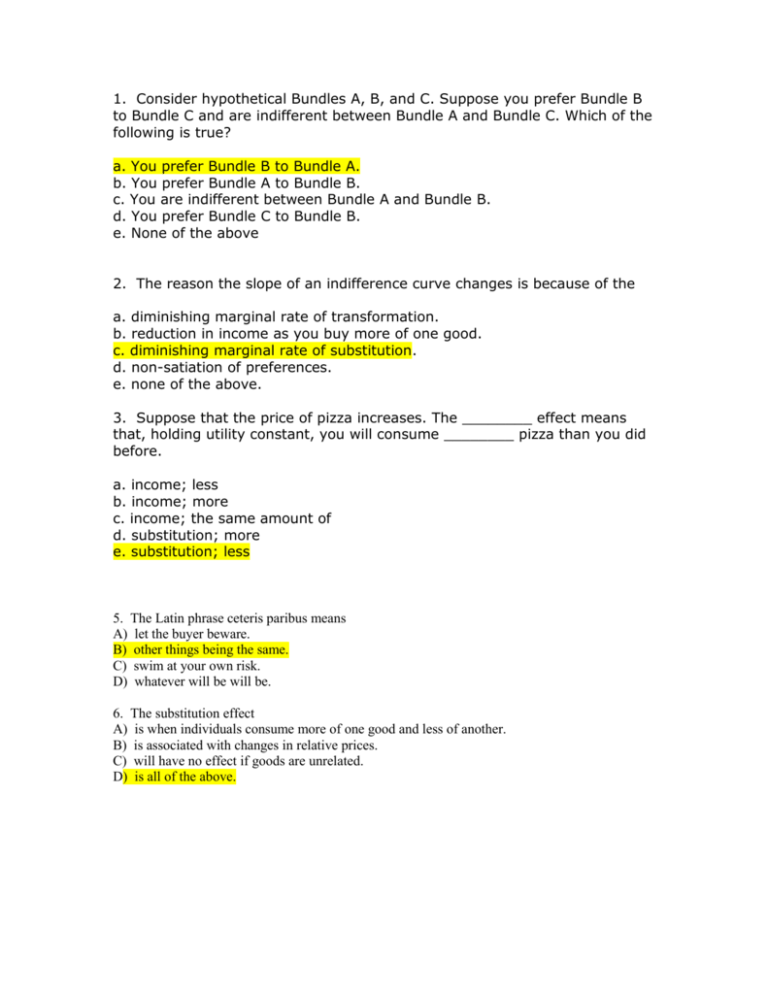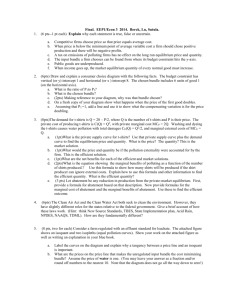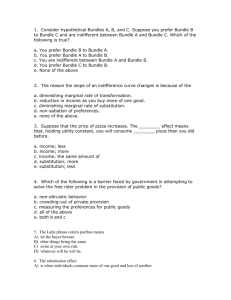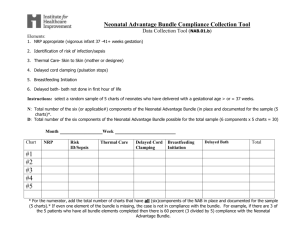Document
advertisement

1. Consider hypothetical Bundles A, B, and C. Suppose you prefer Bundle B to Bundle C and are indifferent between Bundle A and Bundle C. Which of the following is true? a. You prefer Bundle B to Bundle A. b. You prefer Bundle A to Bundle B. c. You are indifferent between Bundle A and Bundle B. d. You prefer Bundle C to Bundle B. e. None of the above 2. The reason the slope of an indifference curve changes is because of the a. diminishing marginal rate of transformation. b. reduction in income as you buy more of one good. c. diminishing marginal rate of substitution. d. non-satiation of preferences. e. none of the above. 3. Suppose that the price of pizza increases. The ________ effect means that, holding utility constant, you will consume ________ pizza than you did before. a. income; less b. income; more c. income; the same amount of d. substitution; more e. substitution; less 5. The Latin phrase ceteris paribus means A) let the buyer beware. B) other things being the same. C) swim at your own risk. D) whatever will be will be. 6. The substitution effect A) is when individuals consume more of one good and less of another. B) is associated with changes in relative prices. C) will have no effect if goods are unrelated. D) is all of the above. 3 According to Coase theorem, externalities can be internalized when transaction costs are zero through: a. corrective taxes and subsidies b) effluent charges c) charging user fees d) assignment of property rights 6. A Pigouvian subsidy a) can not exist with externalities. b) is the same thing as a Pigouvian tax. c) is measured in terms of Pigouvian dollars. d) moves production to the socially optimal level of output. 9. Corrective taxation is best used when which of the following is true? a. Internalizing the externality is difficult. b. The government cannot allocate property rights. c. There are well-defined property rights and costless bargaining. d. All of the above e. Both a and b Answer: e (Pages 131-133) 10. Taxing the producer of an externality based on the amount of the externality produced is equivalent to which of the following? a. Subsidizing the consumer b. Subsidizing those outside the market c. Increasing the producer's input costs d. Increasing the benefits of the consumers in the market e. Both c and d 13. When firms in a polluting industry have different costs for the technology to reduce pollution, which of the following is efficient? a. Mandating equivalent reductions in pollution from all firms b. Mandating that each firm reduce pollution up to the point where the marginal cost of reducing pollution is equal to the total social benefit of the reductions for each firm c. Mandating that each firm reduce pollution up to the point where the marginal cost of reducing pollution is equal to the marginal social benefit of that reduction for each firm d. Mandating that each firm reduce pollution up to the point where the marginal benefit of doing so is zero e. Both a and b Answer: c (Pages 140-144) 29. A subsidy for pollution not produced can induce producers to pollute at the efficient level. A) True. B) False. C) Uncertain. Ans: a 30. Pollution rights can be traded and are always efficient. A) True. B) False. C) Uncertain. Ans: c II. 1. Draw the demand curve Q = 200 – 10P. Calculate the price elasticity of demand at prices of $5, $10, and $15 to show how it changes as you move along this linear demand curve. One way to sketch a linear demand function is to find the x (Q) and y (P) intercepts. Q = 0 when P = $20. When P = 0, Q = 200. Solving for P = $5, Q = 200 – 10(5) = 200 – 50 = 150. Similarly, solving for P = $10, Q = 200 – 10(10) = 100. And solving for P = $15, Q = 200 – 150 = 50. Price elasticity is the percent change in the quantity purchased divided by the percent change in price. To calculate these percentage changes, divide the change in each variable by its original value. Moving in $5 increments: As P increases from $5 to $10, Q falls from 150 to 100. Therefore, P increases by 100% (5/5) as Q falls by 33% (50/150). Elasticity = –0.33/1.00 = –0.33. As P increases from $10 to $15, Q falls from 100 to 50. P increases by 50% (5/10) as Q falls by 50% (50/100). Elasticity = –0.5/0.5 = –1.0. As P increases from $15 to $20, Q falls from 50 to 0. P increases by 33% (5/15) and Q increases by 100% (50/50). Elasticity is –1.0/0.33 = –3.03. Even though the magnitude of the change remains the same (for every $5 increase in price, the quantity purchased falls by 50), in terms of percentage change elasticity of demand increases in magnitude as price increases. 2. You have $100 to spend on food and clothing. The price of food is $5 and the price of clothing is $10. a. Graph your budget constraint. The food intercept (y in the accompanying figure) is 20 units. If you spend the entire $100 on food, at $5 per unit you can afford to purchase 100/5 = 20 units. Similarly, the clothing intercept (x) is 100/10 = 10. The slope, when food is graphed on the vertical axis, will be –2. b. Suppose that the government subsidizes clothing such that each unit of clothing is half-price, up to the first 5 units of clothing. Graph your budget constraint in this circumstance. This budget constraint will have two different slopes. At quantities of clothing less than or equal to 5, the slope will be –1 because 1 unit of food costs the same as 1 unit of clothing ($5). At quantities of clothing greater than 5, the slope will be –2 (if graphed with food on the y-axis), parallel to the budget constraint in a. The point where the line kinks, (5,15), is now feasible. The new x-intercept (clothing intercept) is 12.5: if you purchase 5 units at $5 per unit, you are left with $75 to spend. If you spend it all on clothing at $10 per unit, you can purchase 7.5 units, for a total of 12.5 units. New budget constraint (bold) and original (dashed): The algebra needs to be redone here using Pmc=4Q rather than 6Q Q=36 Tax =72 22. A steel factory has the right to discharge waste into a river. The waste reduces the number of fish, causing damage for swimmers. Let X denote the quantity of waste dumped. The marginal damage, denoted MD, is given by the equation MD = 2 + 5X. The marginal benefit (MB) of dumping waste is given by the equation MB = 34 – 3X. (a.) Calculate the efficient quantity of waste. (b.) What is the efficient fee, in dollars per unit of waste, that would cause the firm to dump only an efficient quantity of waste? (c.) What would be the quantity dumped if the firm did not care about the fishery? Ans: (a.) Set MD = MB and solve for X. X= 4 (b.) Insert 4 into either MD or MB. Fee = 22 (c.) Set MB equal to zero and solve for X. X = 34/3.








